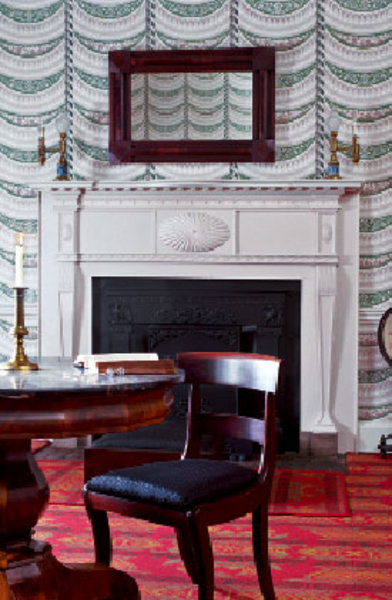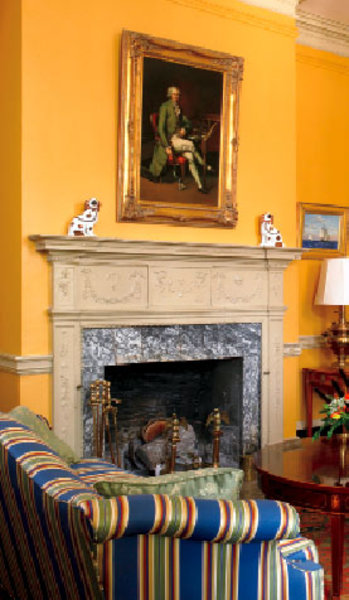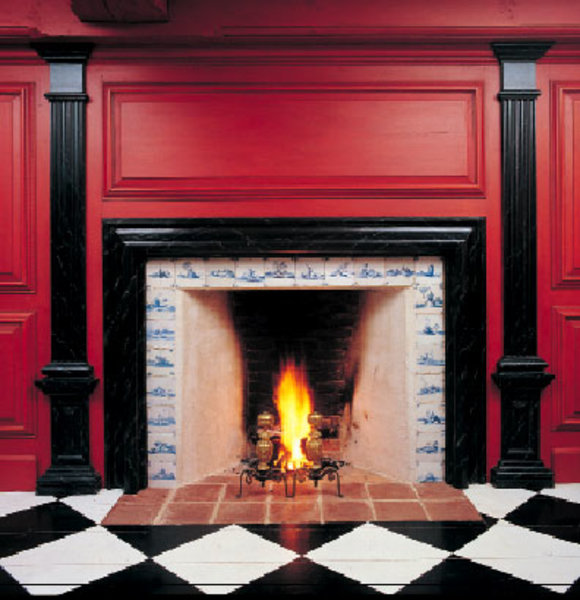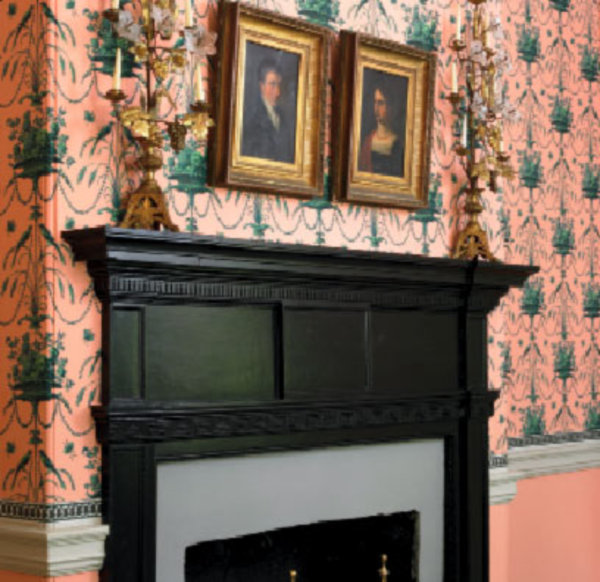
A Federal mantel at a ca. 1815 Palladian house in Louisville, Kentucky, features a sunburst centerpiece and graceful tapering pilasters. (Photo: Franklin & Esther Schmidt)
Set flush with the wall, brick or stone chimneys featured tall, wide firebox openings without much of anything that resembles a modern-day mantel. The openings were huge—so large, in fact, that today we call them “walk-in” fireplaces.
The surrounding wall might be exposed stone or plaster, or, more commonly, plain vertical board paneling. Paneling acted as insulation, and often concealed storage cupboards or a “winder” staircase that led to an upper story. The fireplace surround was equally unfussy, composed of brick or fieldstone. So too was the hearth, the area directly in front of the fireplace. Imported tile was an occasional substitute for local stone or brick.

The delicate garlands on a mantel in an 1803 Federal-style house were inspired by the English Adam style. (Photo: Gridley+Graves)
Although the size of these fireplaces suggest massive log fires or spit-roasted oxen, they were customarily used to house several smaller fires. This allowed one to, say, boil a kettle hung from a lugpole, or simmer a stew in a pot set on a trivet. Bake ovens were built into the back of the firebox or, in later dwellings, to one side. Mantel shelves were largely absent from these first dwellings, but on occasion a narrow, unadorned one has survived, evidence perhaps that even the most harried colonial housewife yearned to display a handful of wildflowers.
These no-frills fireplaces were built right through the 1700s, but with the arrival of the Georgian style by mid-century, wealthier households were installing wide boards with a more polished-looking chamfer edge. They were laid within a rail and stile framework that lent a dignity to the paneling. Rich, wealth-proclaiming paint colors added to the formal effect. There was often a decorative flourish in the shape of an imposing overmantel—a rectangular molded panel that mirrored the dimensions of the firebox opening, often topped with a broken pediment. Despite such elaboration, the mantel was still in essence part of a paneled wall rather than a stand-alone feature.

For much of the 18th century, most fireplaces lacked mantels; instead, the entire wall might be decorated with raised paneling. (Photo: Sandy Agrafiotis)
After the Revolution, the more restrained Federal style gained prominence, releasing walls from somber floor-to-ceiling paneling, and the heavy overmantel fell from popularity. The mantel became the undisputed centerpiece of the main living space. Inspired by the designs of English architect Robert Adam, ornament now was light, delicate, and neoclassical. In fact, the structure of the mantel itself was evocative of a temple, with slender vertical columns or pilasters supporting a horizontal entablature. Composed of the mantel shelf and, beneath it, a wide frieze, this entablature was the perfect ground for ornamentation—motifs such as cornucopia, urns, swags and garlands, lyres, classical deities, sunbursts, and stars. Painted wood continued to be the favored material for mantels, though marble was also in use.
By the 1830s the Greek Revival, or National, style had edged ahead of Federal design, particularly in the American South. Although the two styles had much in common, Greek Revival was more masculine in feel, with a pared-down, post-and-lintel construction. Ornament tended to be more assertive—think of the (now-familiar) Greek key design. Delicate colonnettes gave way to boxier columns and pilasters. Marble was the mantelpiece material of choice, white more so than black. Wood faux-painted to resemble marble was a respectable and less costly alternative. Large mirrors or paintings were hung above the mantel.

This Federal-era country-house mantel in an 1803 Maryland house has a simple dentiled entablature. (Photo: Gridley+Graves)
Colonial Revival homes of the late 19th and early 20th centuries borrowed enthusiastically from all of these precedents for mantelpiece design, though with more of a mix-and-match credo in than in earlier eras. If you are in the market for a reproduction mantel or reproduction fireplace, sources abound, from vintage originals from architectural antiques dealers to reproductions that capture the essence of a particular period. Depending on the era of your house, you may want a purist approach, or something that reflects a combination of styles from early American mantelpieces.







